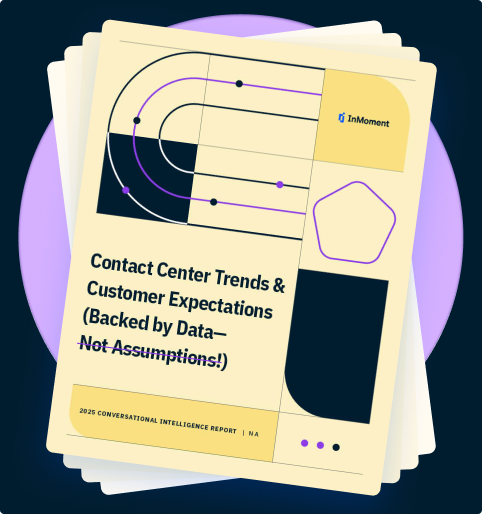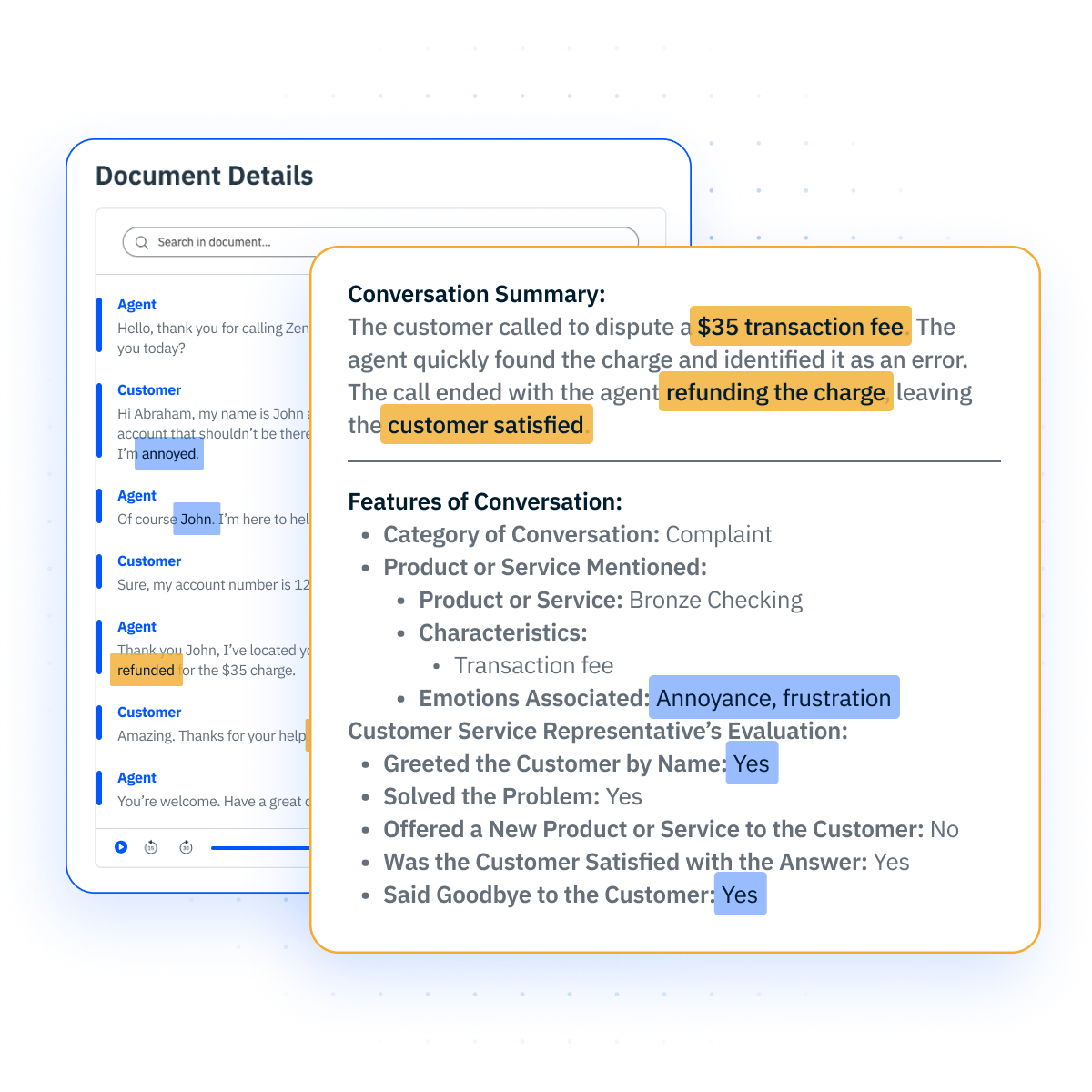7 Benefits of Conversational Intelligence for Team Development and Collaboration
Boost team development with conversational intelligence. Explore 7 ways it improves collaboration, enhances communication, and drives business success.
The path to real improvement starts with understanding.
Effective communication is the foundation of strong teams, enabling them to collaborate, solve problems, and build better relationships with customers and stakeholders. Nowhere is this more critical than in call centers and customer experience teams, where every interaction shapes customer satisfaction, brand perception, and business outcomes.
Conversational Intelligence (CI) is transforming how teams communicate and grow, particularly in environments where clear, real-time interactions are essential—such as call centers. By analyzing conversation patterns, CI helps businesses understand customer needs more deeply, improve team communication, and identify opportunities for training and development.
As a result, teams can build stronger relationships, improve collaboration, and continuously refine their approach to service and engagement.
What Does “Conversational Intelligence” Mean?
Conversational intelligence is the technological ability to understand, analyze, and extract meaning and insights from human dialog (and any other conversational text).
It uses natural language processing (NLP), machine learning (ML), and artificial intelligence (AI) to interpret the sense, tone, content, and even outcome of a conversation. Then CI tools catalog and correlate those observations at scale, revealing patterns in conversational data that businesses can use to improve their operations, performance, and customer satisfaction.
Benefits of Conversational Intelligence for Team Development
Businesses use conversational intelligence for a variety of purposes. It shows up often in marketing and the sales process (such as with location-based campaigns) and retail (in the form of customer feedback)—but it’s also a great tool for developing contact center teams.
Here’s how:
1. Better Coaching and Learning Opportunities
CI gives managers and leaders a clearer sense of how well their CX or contact center teams are performing, even identifying specific topics and responses that frequently lead to bad results.
For example, CI software might identify an unusual number of repeat callers with a similar issue, all of whom got the incorrect answer on call #1. This is a problem every manager wants to solve, but this type of problem could go unnoticed for a long time if you’re using manual methods.
By identifying learning opportunities and coaching needs early, CI software empowers leaders like you to provide more effective coaching, facilitate knowledge sharing, and promote continuous learning within teams.
2. More Effective Meetings
Conversational intelligence tools are also at the heart of the latest generation of smart meeting tools. We’ve had automatic transcription of what was said in a video meeting for some time now, but CI takes that transcription data and makes it even more useful in several ways.
CI tools can intelligently summarize meetings (think smart meeting minutes, but more granular if you need more detail), create action items, advise on next steps, and perform other similar smart tasks. Some CI tools can also automatically translate meeting transcripts into other languages.
Together these capabilities enhance the value and effectiveness of meetings, helping to make sure all team members are aligned on action items and next steps.
3. Better Feedback
When feedback is subjective, left up to the interpretation of individual managers, team members may disagree, resist, or even understand the opposite of what the manager was trying to communicate!
CI helps managers and teams deliver and receive feedback that’s not just opinion—it’s backed up with unbiased evidence that connects behaviors and responses to outcomes.
With CI, feedback isn’t just one person’s point of view anymore. It’s grounded in cold, hard facts. Communication based on facts is clearer, more actionable, and growth-oriented (because it constantly points to outcomes). It helps to grow self-awareness with less defensiveness, reframing issues as growth opportunities requiring follow-up rather than as personal attacks.
4. Greater Productivity and Employee Engagement
CI isn’t just about fixing problems—it also helps businesses lean into what they’re already doing well.
Organizations can use conversational analytics to identify what kinds of conversational approaches are working well and quickly. Then leadership can communicate those successful, productive tactics to entire teams.
As others adopt high-performing approaches and leave behind middling and low-performing ones, productivity ticks upward. What’s more, employees grow more involved because success breeds stronger engagement.
5. Better Conflict Resolution
Conversational intelligence tools also help teams navigate conflict more smoothly. Spotting and addressing problems earlier can tamp down the tension that would otherwise build up.
The neutral, unbiased nature of data helps to lower the temperature, too. Using data to show the connection between behaviors and outcomes keeps things constructive and respectful so they don’t feel quite so personal.
6. Faster Onboarding
When new employees join the team, CI makes it possible to access past customer conversations and see key information in real time. Team members can understand company expectations and culture faster and more fully, and they can also quickly absorb effective ways to interact with customers.
7. Stronger Leadership
Last, CI can make senior leadership more effective in their work. Leaders can more effectively communicate vision and inspire trust when they have an accurate understanding of workplace performance. Leading by example with CI can help transform company culture into one that prioritizes collaboration, motivation, and shared success.
How To Implement Conversational Intelligence Effectively in Your Team
CI adoption starts with software, but doing it right takes more than just purchasing and setting up software. Follow these steps to start gleaning intelligent insights the right way.
Analyze Features and Choose the Right Software
Start by inventorying your needs. What specifically does conversational intelligence software need to accomplish for your business? List these out and start comparing your needs against feature sets from leading CX and CI tools.
Key features to look for:
- Real-time transcription
- Sentiment analysis
- Reporting capabilities
- Translation functionality
If you’re new to CI or moving on from an older solution, don’t limit yourself during this phase. New features and capabilities may meet needs or solve problems that you don’t yet know are fixable.
Ensure Integration With Your Tools
By the time an organization is ready for an enterprise-grade Integrated CX suite, the business already has a complex tech stack in place. A good solution can replace some of the hardware and software you’re already using to run your business, but you’ll still rely on other tools from other providers for some business functions.
Select CI tools that integrate seamlessly with the other tools in your tech stack (like collaboration platforms, CRM systems, and communication software) or that have webhooks or API access so you can build your own integrations. By integrating your CI solution with the rest of your tech stack, you’ll avoid workflow disruptions and duplicate data entry.
Customize for Your Team’s Needs
Every business (and even teams within a business) has its own set of goals, unique outcomes they want to achieve through analytics. With many tools the out-of-the-box settings and reports cover the basics for most customers, but you can unlock much richer and more detailed insights by customizing your CI settings to align with specific departmental or organizational goals.
Train and Onboard Team Members
CI tools can deliver powerful insights, but they can also be daunting—and maybe even frightening to contact center agents who worry about performance oversight or “big brother” listening to their work.
Training is key here. When team members understand the power and value that CI tools offer—including the power to perform better as a call center agent—fear melts away and enthusiasm grows in its place.
And don’t forget an additional layer of practical training or onboarding for the team members and leaders who use your CI suite in a more hands-on way.
Leverage Insights for Actionable Improvements
CI insights are all about improving. Just about any conversational form of data can be studied, and teams can refine and improve their processes based on what they find.
- Refine communication strategies: Repeat successful tactics and eliminate unsuccessful ones.
- Improve coaching: Make it outcome-focused and data-backed rather than personal and opinion-based.
- Enhance collaboration: Identify communication gaps or points of conflict in internal comms.
By acting on trends and feedback you identify using your CI tool, you can lead your team and organization to steady, ongoing growth and improvement.
Empower Your Team’s Growth With Pearl-Plaza’s Conversational Intelligence
Conversational intelligence is a truly transformational technology that helps organizations gain a deeper understanding of what’s happening in customer interactions. It’s a powerful tool for unlocking the full potential of your workforce, helping reps refocus on tactics that work.
Pearl-Plaza is an industry leader in all things customer experience (CX), including conversational intelligence. Pearl-Plaza helps contact centers understand conversational unstructured data at scale, identifying both effective behaviors and business problems to be solved.
Start unlocking your conversational data today: Start your Pearl-Plaza demo now.





